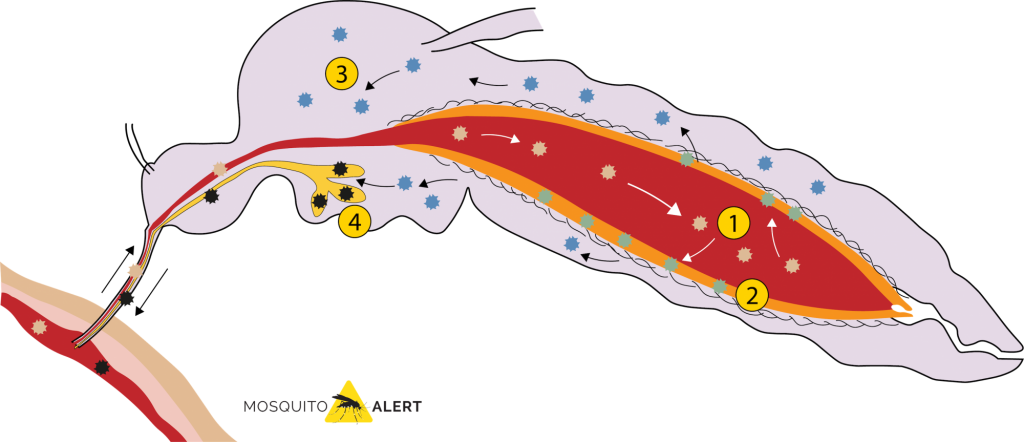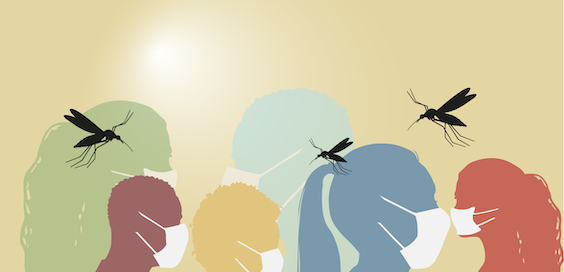With the start of the mosquito season, many people have wondered if the COVID-19 virus, SARS-CoV-2, can be transmitted by mosquitoes. In a previous post, we explained that everything suggested that this was not possible. Arguments based on the knowledge that we have today of the transmission mechanisms of different viruses by mosquitoes. Now researchers have carried out an experiment to demonstrate whether mosquitoes can become infected with SARS-CoV-2 and thus be able to transmit it. The results are clear: mosquitoes are not infected with the virus and therefore cannot transmit it.
In the study, the authors artificially infected mosquitoes of different species: the tiger mosquito (Aedes albopictus), the yellow fever mosquito (Aedes aegypti) and Culex quinquefasciatus, the main transmitter of filiariasis in tropical and subtropical regions. None of the three species was infected with the virus.
Neither the tiger mosquito nor the yellow fever mosquito was infected with the COVID-19 virus.
To demonstrate this, they inoculated a high dose of the virus inside their bodies and studied how the virus progressed within mosquitoes over time. In fact, in the study, in addition to injecting them with a high dose of the virus, they have skipped the first two barriers that viruses must overcome before being able to infect a mosquito’s body: surviving and replicating in their digestive system, and overcoming the basal lamina that surrounds it, represented in the figure with the numbers 1 and 2 respectively.

Fig. 1. The route of infection of a mosquito by a virus, showing the main barriers that it must overcome in order to transmit itself through its bite. (1) Survive the digestive system and replicate. (2) Overcome the basal lamina that surrounds the intestine. (3) Tackle the mosquito’s antiviral immune response without killing it. (4) Reach the salivary glands and overcome their barrier. Image modified from the original by Rückert & Ebel 2018, Trends in Parasitology 34: 310-321. Source: Mosquito Alert (CC-BY-NC-2.0)
For the study, researchers from the University of Kansas have inoculated the virus directly into the cavity of the mosquito’s body (Fig. 1, number 3), which is known as hemocoel, which contains the blood-like fluid of vertebrates from insects: hemolymph.
Looking for the presence of the virus in mosquitoes two hours after infecting them, one day, three days, seven days, ten days and fourteen days, they observed that the virus was only detectable during the first two hours after inoculation (Table with results from the original article Huang et al. 2020). At that time the virus concentration corresponded to the inoculated dose, that is, there was no evidence that the virus was replicating in the mosquito.
| Species | Inoculation | Time | |||||
| 2 hoours | 1 day | 3 days | 7 days | 10 days | 14 days | ||
| Aedes albopictus | SARS-CoV-2 | 5/6 | 1/14 | 0/15 | 0/20 | 0/21 | 0/31 |
| 83,3% | 7,1% | 0,0% | 0,0% | 0,0% | 0,0% | ||
| Aedes aegypti | SARS-CoV-2 | 5/6 | 0/17 | 0/17 | 0/24 | 0/26 | 0/27 |
| 83,3% | 0,0% | 0,0% | 0,0% | 0,0% | 0,0% | ||
| Culex quinquefasciatus | SARS-CoV-2 | 3/3 | 0/17 | 0/17 | 0/25 | 0/28 | 0/25 |
| 100% | 0,0% | 0,0% | 0,0% | 0,0% | 0,0% | ||
A day after the injection with the virus, there was no trace of it in the mosquitoes. The table represents the number of mosquitoes where the virus was detected (for example, 5 out of 6 for Aedes albopictus at two hours, which represents 83.3% of individuals; or only in 1 of 14 mosquitoes analyzed after 24 hours). Beyond the first day, the virus disappeared in the three species studied. In none of the analyzed species did the virus progress, indicating that it is not possible to transmit it.
The study has not yet been reviewed by other specialists, but published as a preprint on the Research Square platform.
References:
Huang YS, Vanlandigham DL, Bilyeu AN, Sharp HM, Hettenbach SM, Higgs S. 2020. SARS.CoV-2 and mosquitoes: an extreme challenge. Preprint from Research Square: 10.21203/rs.3.rs-32261/v1
Rückert C, Ebel GD. 2018. How do virus-mosquito interactions lead to viral emergence? Trends in Parasitology 34: 310-321




